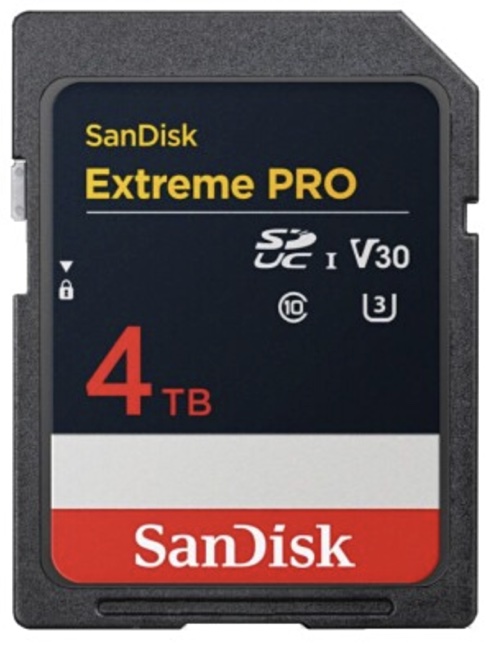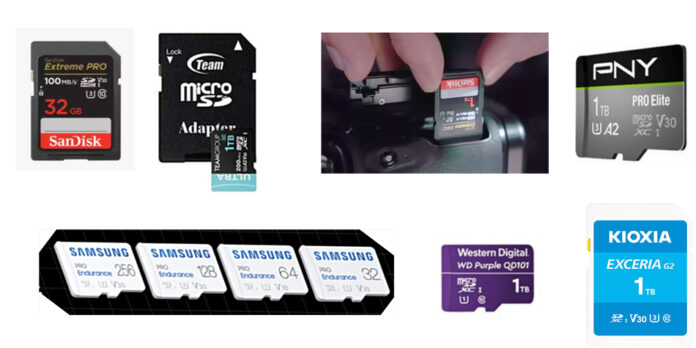The removable Secure Digital (SD) flash card was first presented to the world by Sandisk, Toshiba, and Panasonic (then Matsushita) in 1999 as a way for portable electronic products, such as digital cameras and portable (MP3) media players, to store or load their data, using an external port, and enable its physical transfer to other devices, like PCs.
The three also needed to compete against Sony’s then-popular Memory Stick and the xD-Picture Card pushed by Olympus and Fujifilm. All the suppliers of memory cards and the devices that used them suffered from a fragmented memory card market that limited technology development and market growth. A single standard was needed and the three thought that they could produce it. The SD card controller was mainly developed by Sandisk, based on an existing MultiMedia Card (MMC) design, with Panasonic and Toshiba contributing to the overall product’s spec.

The SD card had a small form factor, 32 x 24 x 2.1 mm, postage stamp size, so it could fit in the target products better than CompactFlash (42.8 x 36.4 x 3.3 mm) or SmartMedia, and had higher capacities than those alternatives as well. Its initial capacities ranged from 8 MB to 64 MB. The three originating suppliers created the SD Association in 2000 to provide SD standards ensuring compatibility across target devices and SD manufacturers. The first standard defined an 8 MB to 2 GB range – tiny by today’s standards. Current Sandisk Extreme PRO SDHC cards have a 32 GB to 2 TB capacity range, a thousandfold increase at the high end.
The original SD card had a transfer rate of 12.5 MBps across its bus interface. A high-speed mode raised this to 25 MBps. Again, this is very slow compared to later standards like v8’s 3.94 GBps.
A smaller miniSD format (20 x 21.5 mm) for mobile phones was introduced in 2003 but was quickly superseded by the even smaller microSD design (15 x 11 mm) a year later.
Other SD formats were introduced to provide higher speeds and capacities:
- SDHC (Secure Digital High Capacity) in 2006 with up to 32 GB
- SDXC (Secure Digital eXended Capacity) in 2009 with up to 2 TB capacity and 300 MBps speed
- SDUC (Secure Digital Ultra Capacity) in 2018 supporting up to 128 TB and 985 MBps speed
These three formats have higher speeds than the SD format as they used the UHS (Ultra High Speed) bus interface. To complicate matters, this came in several versions – UHS-1, UHS-II, UHS-III and Express – and versions could have their own transfer modes operating at different speeds.
SD cards have to interface to the mobile device, and each type can have its own way of connecting to the card, but also to PCs and laptops, and they have standardized internal interconnects, which in 1999 meant the PCI (Peripheral Component Interconnect) bus. That evolved to the PCIe (PCI Express) standard in 2003, with gen 1 having ~250 MBps per lane speed compared to PCI’s 133 MBps. PCIe gen 2 came along in 2007 with ~500 MBps per lane speed.
The evolving PCI/PCIe standards meant that the SD standard had to evolve with them. The main SD standard versions and changes have been:
- v1.0 in 2000
- v2.0 in 2006, which added SDHC
- v3.1 in 2010 with SDXC and UHS-I
- v4.1 in 2013 introduced the UHS-II bus
- v5.0 in 2016 added special video speed types
- v6.0 in 2017 added app performance specifications
- v7.0 in 2018 with SD Express, microSD Express, SDUC and PCIe Gen 2 and Gen 3, and NVMe support, with speeds up to 985 MBps
- v8.0 in 2020 added PCIe Gen 4 support with speeds up to 3.94 GBps and microExpress card doubled max speed to 2 GBps with single-lane PCIe Gen 4 lane support
- v9.0 in 2022 with security, power, and thermal management features
- v9.1 in 2023 with extra SD Express speed classes
The SD products depended for their raison d’être on there being no cable or radio communication alternative. The rise of Bluetooth meant short-range radio links between a portable device, like a digital camera or gaming console, and a PC/laptop could obviate the need for an SD card. The convergence of portable devices into the mobile phone, which is now a camera and media player as well, meant that data transfer by radio communications became more common still. SD cards can still bulk out a smartphone or digital camera’s memory capacity, of course. Whole new sub-markets have sprung up, such as dash and drone cams.
5.6 billion units of SD cards shipped in 2023, with microSD cards accounting for nearly 72 percent of them due to their widespread use in smartphones and IoT devices, such as drones with their cameras. The SD card market was valued at $17.5 billion that year and it’s estimated to reach $24.8 billion by 2032 – a 3.9 percent compound annual growth rate (CAGR).
Other estimates differ. Metastat, for example, says that the global SD memory card market was estimated to reach $9.52 billion in 2024 with a CAGR of 2.5 percent from 2024 to 2031.
PCIe 5.0 and PCIe 6.0 are coming, which will mean the SD card standard will need revising to support them. There is, as yet, no v10.0 SD card standard but we can be sure some SD card manufacturers in the SD Association are thinking about it.
The SD card has been a hugely successful technology, unifying a divided memory card market and driving continuous technology development, producing larger capacities and higher speeds. This enabled the cards to keep up as, for example, digital camera resolutions, and hence image sizes, increased. For more, read “Celebrating 20 years of microSD” by Sandisk Senior Technologist Yosi Pinto, who contributed to the first SD card standard.








